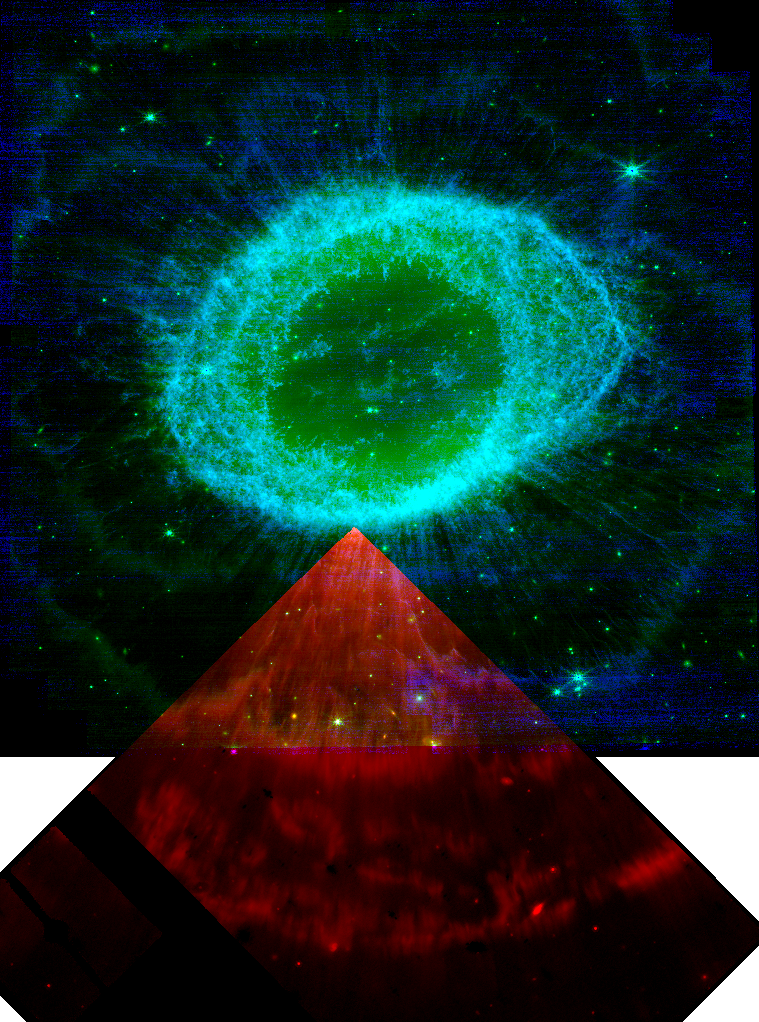Hopalong wrote: ↑Fri Aug 18, 2023 3:38 am
Many thanks, Ann. Earth is 150 million km from the sun, and there are days when it's scorchingly hot here (even in the shade) ... so if the white dwarf in the Ring nebula is 22 times hotter, humans had better keep at least 3300 million km from it - but who's going to hold the end of the tape at the white dwarf?

My second question was: what are the other white spots? Are they also other white dwarf stars, possibly further away? (If so, who'd want to think about going there?)
The other stars are just stars, ordinary stars.
Take a look at the four exposures through different filters of the Ring Nebula again:
Note the star to the left of the Ring Nebula. It shows up well in all of the exposures except the 5007 Å, where it appears to be invisible. Actually it is not, though. If you look at the full size of the picture, you can see it, although very faintly.
The likely reason why the star looks so faint at 5007 Å is that the 5007 Å wavelength corresponds to doubly ionized oxygen, where the Ring Nebula is very bright indeed. If you ask me, I'd say that the 5007 Å image may be "underexposed" so as not to be too bright. The star became "underexposed" and faint as well.
Correspondingly, the 4686 Å image may be overexposed, and the star may be overexposed and "too bright" as well.
Let's look at a Hubble image of the Ring Nebula where some of the other stars can be seen:
As you can see, the star to the left of the Ring Nebula shows up well in the Hubble image. It looks white, maybe a little bit reddish. One star to the upper right of the Ring Nebula is also visible, and it also looks white. In the "four series exposures", both stars show up in the orange 6300 Å exposure as well as in the blue 4685 one. These two stars are not hot and blue.
Note however that we can see several stars in the inner blue center of the Ring Nebula. The white dwarf is seen in the center of it, but there is a fairly bright star to the upper right of it. If you look at the series of four exposures of the Ring Nebula through different filters, you can indeed spot this star in the 4686 Å image. You can actually also see another star here, namely right at the lower right edge of the "inner nebula", at the 5 o'clock position.
You can see this star, the one to the upper right of the central white dwarf, in the 5861 Å exposure as well. This star could be a background star that is indeed hot and blue, although nowhere near as hot and blue as the white dwarf! Because normal stars are never as hot as white dwarfs.
The reason why white dwarfs are so hot and blue (when they are young) is that they are the exposed cores of dead stars. Remember that if the temperature of the white dwarf inside the Ring Nebula is 125,000 K, that is actually not nearly as hot as it was when the now-white dwarf was a stellar core wrapped in thick layers of hydrogen and helium. After all,
the core of our own Sun is 15 million K! Compared with that, 125,000 K is nothing! Yes, but the photosphere of the Sun, the "visible apparent surface" of the Sun, is barely 6,000 K!
Young white dwarfs are the exposed naked cores of dead stars which have shed their "wrapping" of gases surrounding them. In planetary nebulas, it is these "wrappings" that are ionized by the blasts of ultraviolet light from the scorchingly hot core. The "wrappings" are quickly dispersed by the brutal onslaught of ultraviolet photons and stellar wind from the white dwarf, destroying the planetary nebula and leaving only the cooling white dwarf behind.
Let's take a look at some white dwarfs inside globular cluster M4:
The circled little dots in the picture at right are white dwarfs in globular cluster M4. You can see how tiny and faint they are, but you can also see that they are bluish. Their blue color means that they are hotter than the other stars in the picture. However, white dwarfs keep radiating their heat into space, and since they can't produce any new energy, they keep getting cooler and cooler. After a sufficient number of billion years they won't be blue any more, and in the end they will become burnt-out black cinders.
M4 is a very old globular cluster, some 12 to 13 billion years old. So the oldest white dwarfs in M4 may be almost 12 to13 billion years old, too. These very oldest white dwarfs must have cooled so that they are not blue at all any more, but they are far from being stone cold black dwarfs.
But this is my point: We have very good reasons to believe that all the other stars that we can see in the direction of the Ring Nebula are ordinary stars and not white dwarfs. Yes, there are lots of white dwarfs in the Milky Way, but unless they are so young that they are surrounded by a planetary nebula they are very faint indeed, and they would have to be far in the foreground to show up in a picture of the Ring Nebula.
Ann
 The Ring Nebula from Webb
The Ring Nebula from Webb



